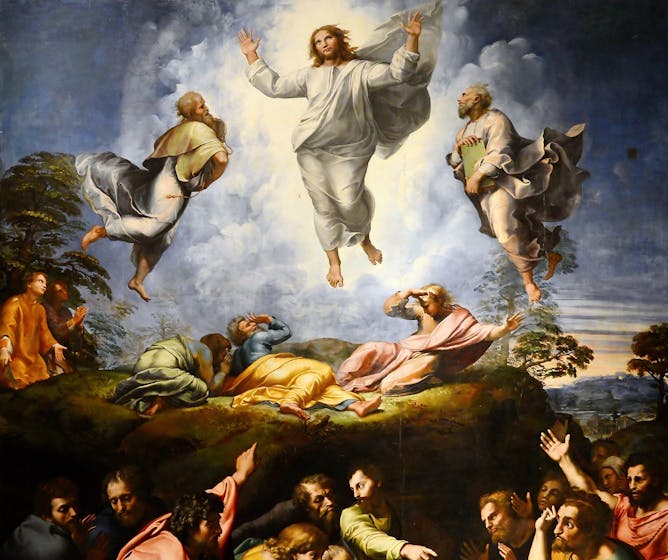|
In the national outcry over racial justice, scholars, protesters and even the archbishop of Canterbury have questioned the portrayal of Jesus as white. No one knows exactly what the historical Jesus looked like, but coming from Galilee, a region in biblical Israel, he likely had a brown skin tone.
University of South Carolina art historian Anna Swartwood House traces centuries of early European artists who combined images of Jesus with their own likeness, to later representations of a light-skinned Christ spread around the world through trade and colonization.
This representation, House says, “reinforced a caste system” in which darker-skinned people were ranked lower and was used to “justify the oppression of Native and African Americans.”
Also today:
|

Painting depicting transfiguration of Jesus, a story in the New Testament when Jesus becomes radiant upon a mountain.
Artist Raphael /Collections Hallwyl Museum
Anna Swartwood House, University of South Carolina
Recent protests on racial justice have also questioned the portrayal of Jesus as a white man. An art historian explains how this image appeared and came to be marketed worldwide.
|
Health
|
-
Tiffany A. Radcliff, Texas A&M University ; Murray J. Côté, Texas A&M University
A close look at Florida's economy shows just how vulnerable the state and its population are to a pandemic.
|
|
Video
|
-
Sanjay Mishra, Vanderbilt University
The results from the phase 1 trial are a promising first step in showing that the mRNA vaccine is a viable candidate, but there are unanswered questions and it is still early in the process.
|
|
Environment + Energy
|
-
Michael Fakhri, University of Oregon; Ntina Tzouvala, Australian National University
A new UN report shows that hunger and food insecurity are rising worldwide. The COVID-19 pandemic is adding to this trend, but is not the major driver.
|
|
Politics + Society
|
-
Stanley M. Brand, Pennsylvania State University
A former lawyer for the US House of Representatives explains the constitutional and historical limits barring Congress from checking the president's clemency powers.
-
Mary Ziegler, Florida State University
People who object to the landmark 1973 Roe v. Wade ruling legalizing abortion have fought it for years. A recent Supreme Court decision makes the fight much easier.
-
Jordan Brasher, Columbus State University
Symbols of the Confederacy can be seen in Brazil, Ireland, Germany and beyond. While some people may not grasp their racist history, others clearly fly the 'rebel flag' to defend white supremacy.
|
|
From our International Editions
|
-
Gavin Evans, Birkbeck, University of London
Mandela left at the right time in 1999, when the country still seemed in a healthy state, after which he consolidated his international reputation.
-
Gareth Dorrian, University of Birmingham; Ian Whittaker, Nottingham Trent University
Neowise has an orbit of almost 6800 years, meaning that the last generation of people to see it would have lived during the 5th millennium BC.
-
Warren Mabee, Queen's University, Ontario
Buildings account for a large proportion of greenhouse gas emissions globally. Sustainably sourced wood could be a better building material.
|
|